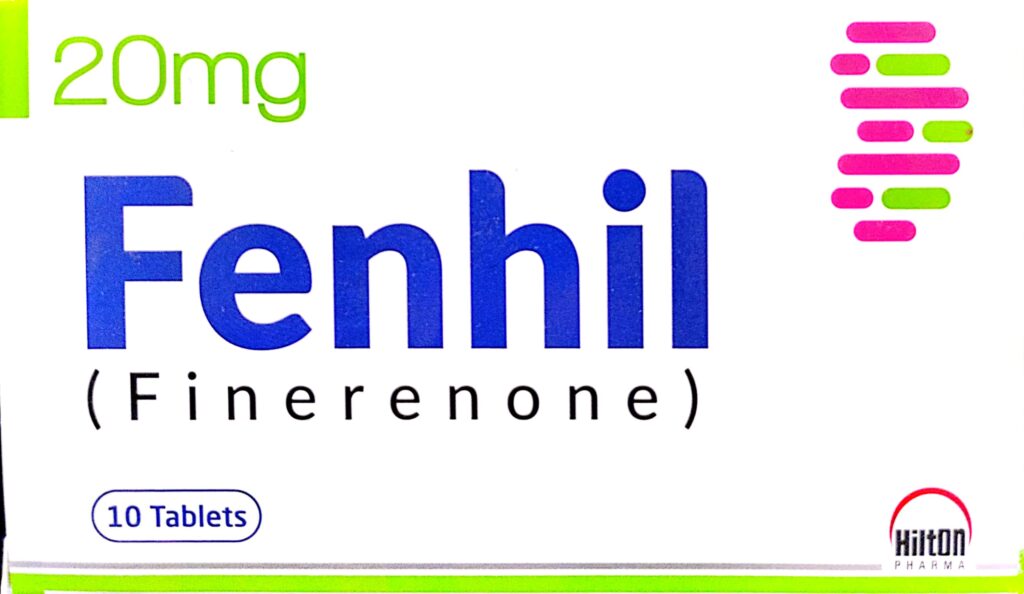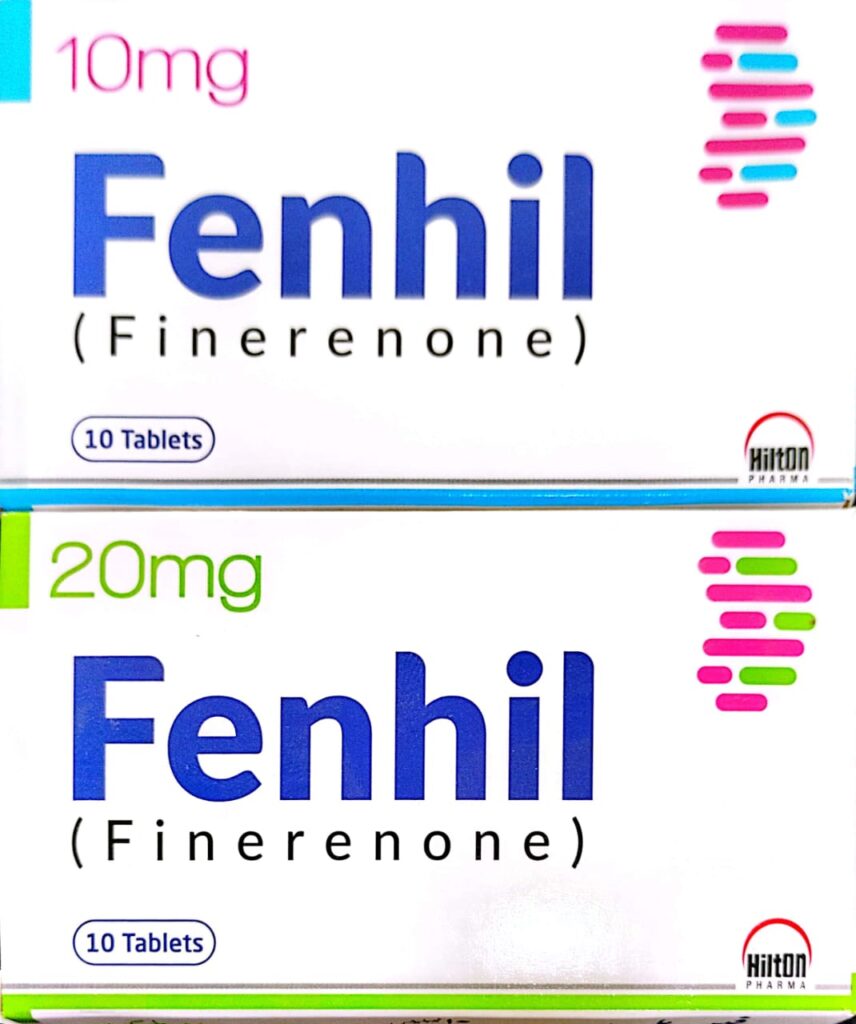Fenhil (Finerenone)
Tablets
DESCRIPTION
Fenhil contains Finerenone, a nonsteroidal mineralocorticoid receptor antagonist. Finerenone’s chemical name is (4S)-4-(4-cyano-2- methoxyphenyl)-5-ethoxy-2,8-dimethyl-1,4-dihydro-1,6-naphthyridine-3-carboxamide. The molecular formula is C21H22N4O3 and the molecular weight is 378.43 g/mol.
Fenhil 10mg Tablets
Each film-coated tablet contains:
Finerenone….10mg.
Fenhil 20mg Tablets
Each film-coated tablet contains:
Finerenone……………..20mg.

CLINICAL PHARMACOLOGY
Mechanism of Action
Finerenone is a nonsteroidal, selective antagonist of the mineralocorticoid receptor (MR), which is activated by aldosterone and cortisol and regulates gene transcription. The MR is expressed in the kidneys, heart and blood vessels. Finerenone blocks MR mediated sodium reabsorption and MR overactivation in both epithelial (e.g., kidney) and nonepithelial (e.g.. heart, and blood vessels) tissues. MR overactivation is thought to contribute to fibrosis and inflammation. Finerenone has a high potency and selectivity for the MR and nas no relevant affinity for androgen, progesterone, estrogen, and glucocorticoid receptors. Pharmacodynamics: In multicenter, placebo controlled studies in adult patients with chronic kidney disease associated with type 2 diabetes, relative reduction in urinary albumin-to-creatinine ratio (UACR) in patients randomized to Finerenone was 32% (95% CI 30-35%) at Month 4 and remained stable for the duration of the trial.
In another randomized, double-blind, study in adults with CKD and T2D, the relative reduction in UACR at Day 90 was 25% and 38% in patients treated with Finerenone 10 mg and 20 mg once daily, respectively.
In patients treated with Finerenone, the mean systolic blood pressure decreased by 3 mmHg and the mean diastolic blood pressure decreased by 1-2 mmHg at month 1, remaining stable thereafter.
Cardiac Electrophysiology
At a dose of 80 mg, Finerenone does not prolong the QT interval to any clinically relevant extent. Pharmacokinetics: Finerenone exposure increased proportionally over various dose ranges of 1.25 to 80 mg (0.06 to 4 times the maximum approved recommended dosage). Steady state of Finerenone was achieved after 2 days of dosing. The estimated steady-state geometric mean Cmax, md was 160 μg/L and steady-state geometric mean AUCT.md was 686 ug.h/L following administration of Finerenone 20 mg to patients..
Absorption:
Finerenone is absorbed completely after oral administration and undergoes metabolism resulting in absolute bioavailability of 44%. Finerenone Cmax was achieved between 0.5 and 1.25 hours after dosing.
Effect of Food
No clinically significant effect of food is seen on Finerenone AUC following administration with high fat, high calorie food.
Distribution
At steady-state (Vss) the volume of distribution of Finerenone is 52.6 L. Plasma protein binding of Finerenone is 92%, primarily to serum albumin, in vitro.
Elimination
The terminal half-life of Finerenone is about 2 to 3 hours, and the systemic blood clearance is about 25 L/h.. Metabolism: Finerenone is primarily metabolized by the metabolic pathway using CYP3A4 (90%) and to a lesser extent by CYP2C8 (10%) to inactive metabolites.
Excretion
The urinary excretion is about 80% of the administered dose (<1% as unchanged) and fecal excretion is approximately 20% (<0.2% as unchanged).
Specific Populations
The age (adult), sex, race or weight has no clinically significant effect on the pharmacokinetics of Finerenone.
Renal Impairment
There were no clinically relevant differences in Finerenone AUC or Cmax values in patients with eGFR 15 to < 90 mL/min/1.73m2 compared to eGFR 2 90 mL/min/1.73 m2. For dosing recommendations based on eGFR and serum potassium levels should be monitored
Hepatic Impairment
Mild hepatic impairment has no clinically significant effect on Finerenone exposure in cirrhotic patients (Child Pugh A). In patients with moderate hepatic impairment (Child Pugh B) Finerenone mean AUC was increased by 38% and Cmax was unchanged compared to healthy control subjects. The data for effect of severe hepatic impairment (Child Pugh C) on Finerenone is not available.

INDICATIONS AND USAGE
Fenhil is indicated to reduce the risk of sustained eGFR decline, end-stage kidney disease, cardiovascular death, non-fatal myocardial infarction, and hospitalization for heart failure in adult patients with chronic kidney disease (CKD) associated with type 2 diabetes (T2D). DOSAGE AND
ADMINISTRATION
Prior to Initiation of Fenhil (Finerenone)
Measure serum potassium levels and estimated glomerular filtration rate (eGFR) before initiation. Do not initiate treatment if serum potassium is > 5.0 mEq/L.
Recommended Starting Dosage: The recommended starting dose of Fenhil (Finerenone) is based on eGFR and is presented in table below.
Table: recommended starting dose
| eGFR (mL/min/1.73m2) | Starting dose |
| ≥ 60 | 20 mg once daily |
| ≥ 25 to < 60 | 10 mg once daily |
| < 25 | Initiation is not recommended |

Monitoring and Dose Adjustment
The target daily dose of Fenhil (Finerenone) is 20 mg.
Measure serum potassium 4 weeks after initiating treatment and adjust dose (see table below); if serum potassium levels are > 4.8 to 5.0 mEq/L, initiation of Fenhil (Finerenone) treatment may be considered with additional serum potassium monitoring within the first 4 weeks based on clinical judgment and serum potassium levels. Monitor serum potassium 4 weeks after a dose adjustment and throughout treatment, and adjust the dose as needed (see Table below)
Table : Dose Adjustment Based on Current Serum Potassium Concentration and Current Dose
| Current Fenhil Dose | |||
| 10 mg once daily | 20 mg once daily | ||
| Current Serum potassium (mEq/L) | ≤ 4.8 | Increase the dose to 20 mg once daily. | Maintain 20 mg once daily. |
| ˃ 4.8 – 5.5 | Maintain 10 mg once daily. | Maintain 20 mg once daily. | |
| ˃ 5.5 | Withhold Fenhil. Consider restarting at 10 mg once daily when serum potassium ≤ 5.0 mEq/L. | Withhold Fenhil. Consider restarting at 10 mg once daily when serum potassium ≤ 5.0 mEq/L. | |
Missed doses
Advise the patient to take a missed dose as soon as possible after it is noticed, but only on the same day. If this is not possible, the patient should skip the dose and continue with the next dose as prescribed.

Special populations
Elderly
No dose adjustment is necessary in elderly patients.
Renal impairment
Initiation of treatment
In patients with eGFR< 25 mL/min/1.73 m2, Fenhil (Finerenone) treatment should not be initiated due to limited clinical data.
Due to limited clinical data, Finerenone treatment should be discontinued in patients who have progressed to end-stage renal disease (eGFR< 15 mL/min/1.73 m2).
Hepatic impairment
Patients with
- mild hepatic impairment
No initial dose adjustment of Fenhil (Finerenone) is required. - moderate hepatic impairment
No initial dose adjustment of Fenhil (Finerenone) is required. However, consider additional serum potassium monitoring and adapt monitoring according to patient characteristics. - severe hepatic impairment
Fenhil (Finerenone) should not be initiated.
Paediatric population
The safety and efficacy data of Finerenone in children and adolescents aged under-18 years is not available.
- CONTRAINDICATIONS
- Fenhil (Finerenone) is contraindicated in patients:
- Who are receiving concomitant treatment with strong CYP3A4 inhibitors.
With adrenal insufficiency.
Hypersensitivity to the active substance or to any of the excipients
WARNINGS AND PRECAUTIONS: Hyperkalemia
Finerenone can cause hyperkalemia. The risk for developing hyperkalemia increases with decreasing kidney function and is greater in patients with higher baseline potassium levels or other risk factors for hyperkalemia. It is advised to measure serum potassium and eGFR in all patients before initiation of treatment with Fenhil and dose accordingly. Do not initiate Fenhil if serum potassium is > 5.0 mEq/L.
Measure serum potassium periodically during treatment with Fenhil and adjust dose accordingly. More frequent monitoring may be necessary for patients at risk for hyperkalemia, including those on concomitant medications that impair potassium excretion or increase serum potassium.
Lactose: The tablets contain lactose. Patients with rare hereditary problems of galactose intolerance, the Lapp lactase deficiency, or glucose-galactose malabsorption should not take this medicinal product. - ADVERSE REACTIONS
The most frequently reported adverse reaction under treatment with Finerenone was Hyperkalemia.
Table below shows adverse reactions that occurred more commonly on Finerenone than on placebo, and in at least 1% of patients treated with Finerenone:
Adverse reactions reported in ≥ 1% of patients on Finerenone and more frequently than placebo (pooled data from two clinical studies)
| Adverse reactions | Finerenone N =6510 n (%) | Placebo N =6489 n (%) |
| Hyperkalemia | 912 (14.0) | 448 (6.9) |
| Hypotension | 302 (4.6) | 194 (3.9) |
| Hyponatremia | 82 (1.3) | 47 (0.7) |

DRUG INTERACTIONS
CYP3A4 Inhibitors and Inducers
Strong CYP3A4 Inhibitors
Finerenone is a CYP3A4 substrate. Concomitant use with a strong CYP3A4 inhibitor may increase the risk of Finerenone adverse reactions. Use of Fenhil (Finerenone) concomitantly with strong CYP3A4 inhibitors is contraindicated. Avoid concomitant intake of grapefruit or grapefruit juice.
Moderate and Weak CYP3A4 Inhibitors
Concomitant use with a moderate or weak CYP3A4 inhibitor increases Finerenone exposure, which may increase the risk of Finerenone adverse reactions. It is advised to monitor serum potassium during drug initiation or dosage adjustment of either Fenhil or the moderate or weak CYP3A4 inhibitors, and adjust dosage as appropriate.
Drugs That Affect Serum Potassium
More frequent serum potassium monitoring is advised in patients receiving concomitant therapy with drugs or supplements that increase serum potassium.

USE IN SPECIFIC POPULATIONS:
Pregnancy
Fenhil (Finerenone) should not be used during pregnancy unless there has been careful consideration of the benefit for the mother and the risk to the fetus.
Lactation
Because of the potential risk to breastfed infants from exposure to Finerenone, avoid breastfeeding during treatment with Fenhil and for 1 day after treatment.
Pediatric Use
Fenhil (Finerenone) is not indicated in patients below 18 years of age
Geriatric Use:
No dose adjustment is required for the elderly patients between the age group of 65 to 75 years of age.
Hepatic Impairment
Do not use Finerenone (Fenhil) in patients with severe hepatic impairment (Child Pugh C).
Dosage adjustment is not required in patients with mild or moderate hepatic impairment (Child Pugh A or B). However, additionally serum potassium monitoring is advised in patients with moderate hepatic impairment (Child Pugh B).
OVERDOSAGE
In the event of suspected overdosage, immediately stop Fenhil treatment. The most likely manifestation of overdose is hyperkalemia. If hyperkalemia develops, standard treatment should be initiated.
Finerenone is unlikely to be efficiently removed by hemodialysis given its fraction bound to plasma proteins of about 90%. INSTRUCTIONS:
Store below 30°C. Protect from sunlight and moisture.
Keep out of reach of children.
HOW SUPPLIED
Fenhil 10mg Tablets: Alu-Alu blister pack of 1×10’s Tablets Fenhil 20mg Tablets: Alu-Alu blister pack of 1×10’s Tablets
خوراک: ڈاکٹر کی ہدایات کے مطابق استعمال کریں۔ ہدایات : ۳۰ ڈگری سینٹی گریڈ سے کم درجہ حرارت پر رکھیں۔
سورج کی روشنی اور نمی سے بچائیں۔ بچوں کی پہنچ سے دور رکھیں۔
Manufactured by:
Hilton Pharma (Pvt.) Ltd. Hilton Plot No. 13-14 & 43, Sector-15, Korangi
HARMA Industrial Area, Karachi, Pakistan.
5216/02
